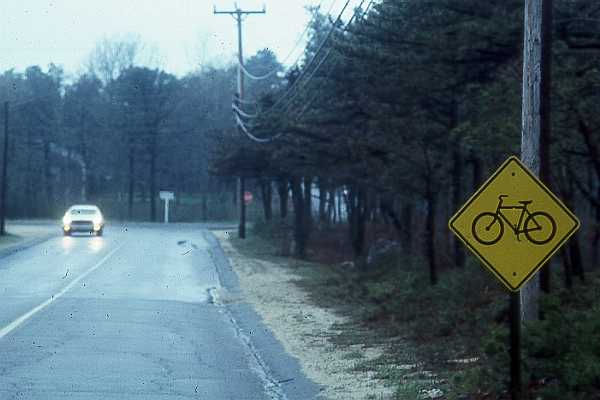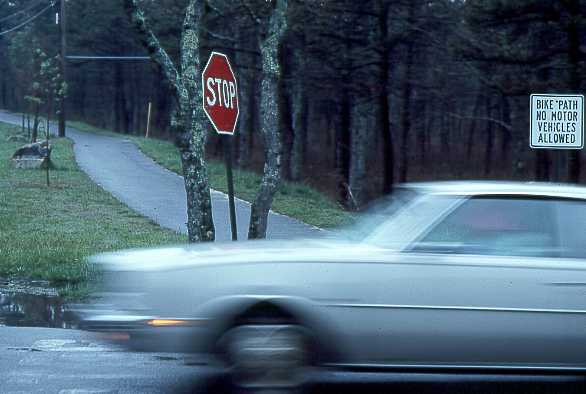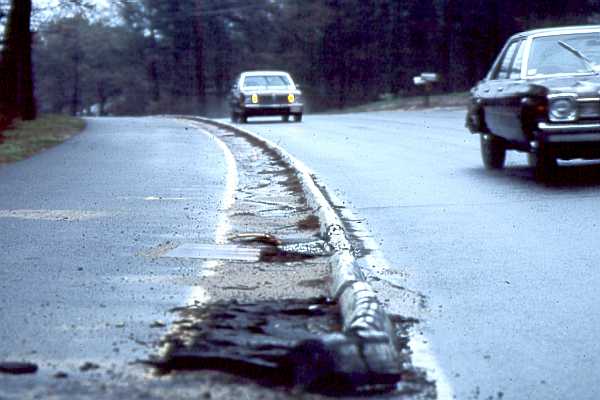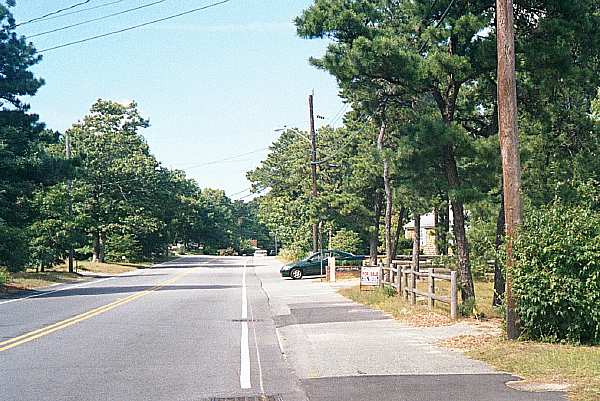
Top: Home Page
Up: Table of Contents
Previous:
Next:
This sign on Bob Crowell Road in Dennis -- an important connection between Route 6 and Old Bass River Road -- conveys two faulty messages. One is that there are bicyclists somewhere without indicating where. The other is that bicyclists really only should be expected where such signs are found . (Photos taken 1985). |
Bob Crowell Road looking toward Old Bass River road, 1985

The photo below shows the intersection for which that sign provides its faulty warning. The Old Bass River Road Bicycle Path runs along the east side of Old Bass River Road, a minor north-south arterial through Dennis. Old Bass River Road is just outside the left side of the photo. As was typical with Massachusetts sidepaths, the stop line is after the bicycle path.. (The stop line is at the lower left of the picture, and worn to near invisibility.) Also as was typical, there are no crosswalk markings. The risk for bicyclists headed toward the camera at this type of intersection is extremely high, as shown by one accident study after another. |
Old Bass River road bicycle path at Bob Crowell Road, 1985

As of 2001, the intersection has been somewhat improved. The stop sign and the stop line are now ahead of the crosswalk (the stop sign is on the signpost above the car's hood), and the paint is not as badly worn. It also appears that drainage has been improved with a new storm grate (to the left of the crosswalk on the far side of Bob Crowell Road). |
Old Bass River road bicycle path at Bob Crowell Road, 2001

North of Bob Crowell Road on the path, there is a wooden barrier which is of little use in preventing out-of-control cars from driving onto the path, as it is up an embankment. However, its low height and the pedal-snagging posts guarantee that a bicyclist who runs into it will topple over into the road. The retaining wall at the left side of the photo below narrows the path further, increasing risks when there is two-way path traffic. The path here conforms to the minimum 8-foot paved width specified under AASHTO bicycle facilities guidelines. However, only about 5 feet of the paved width are usable because of the absence of AASHTO-specified shoulders. |

| As shown in the photo below, the barrier has been interrupted here for a driveway. The raised path makes driveway entrances and exits awkward (1985 photo). |

Here, the path is at the same level as the road, and separated by broken asphalt curbing (1985 photo).. |

Part of the path is next to the road with no separation (2001 photo). All of these conditions, as well as the sidewalk-like location of the path, fail to conform to AASHTO guidelines. |

| My critiques of the path's hazards for bicyclists are probably of little concern,
because very few bicyclists use the path. This situation was predictable. Massachusetts
Bicycle Route 1 makes a detour to the south to use the Old Bass River Road path and make a
connection with the western end of the Cape Cod Rail Trail. Most bicycle tourists avoid
this detour, continuing on Setucket Road or taking an entirely different route to connect
with the Rail Trail farther to the east. There is also relatively little local bicycle traffic on the Old Bass River Road path. Traffic generators such as shopping areas, workplaces or schools are spread rather far apart in this low-density residential area, and most residents don't ride bicycles for transportation. Residents who ride for recreation prefer the more scenic Cape Cod Rail Trail, or the roads. The Old Bass River Bicycle Path satisfied the desire of the community for a sidewalk, and was cleverly funded by state bicycle money so the community would not have to pay for one. |